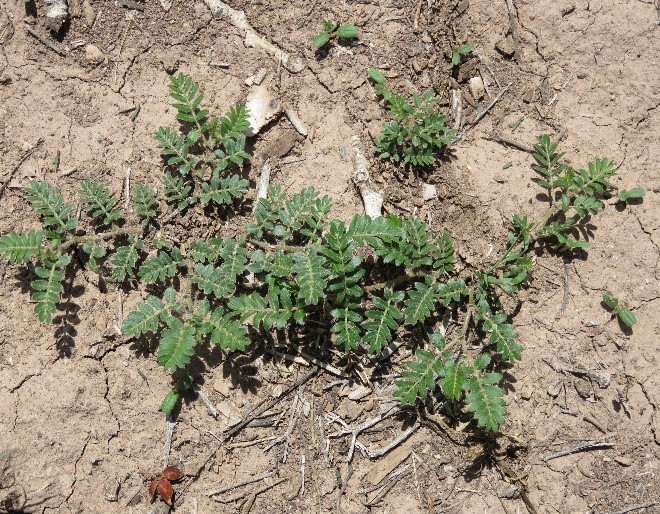Puncture vine (a.k.a. Goathead) Tribulus terrestris

If you are new to gardening in New Mexico, you may not be familiar with the puncture vine, but once you step on one, you will become acquainted with this invasive weed very quickly. They are built to survive in an arid climate, and the seeds may last upward of twenty years, just waiting for the right climate in which to sprout. They are called goat heads because the fruit resembles the head of a goat or a bull. The fruits break up into several sections with very sharp barbs that stick to shoes, tires, and pets’ feet. They are very painful when stepped on. My first encounter with the weeds was shortly after we moved here and we decided to take a walk on a levee along the Rio Grande. When we returned to our car, the soles of our shoes were full of the spikes. I was finally able to get them out of my shoes, but my wife threw her shoes away because the spikes were embedded so deeply that they could not be removed. If you are not familiar with the plants, it’s best to go to the Internet, such as (http://ipm.ucanr.edu/PMG/PESTNOTES/pn74128.html) for a fuller description, and to see pictures; but here is a brief summary of what to look for. The plants are prostrate with hairy stems that branch from the crown, and the leaves are opposite and pinnately compound to 1/8 inch long The flowers are yellow and about 6mm wide. Plant size varies. They may be a few inches wide as the vines trail out from the root, or they may reach several feet under the right conditions. They usually grow in barren or disturbed locations such as construction areas, parking lots, driveways, and vacant land, as they do not compete well with other plants. They are annuals, and will die with the first frost, but will leave behind seeds that may remain dormant for several years. Because it may take only a few weeks for new plants to sprout from some of the seeds, it is important to remove the plants and any fruit quickly when discovered. I favor physical removal because chemical treatment may leave the seeds behind.The only known way to destroy the seeds is fire. A propane torch will work well on a driveway or vacant lot, but if the goat heads are growing among other plants, they will go up in smoke also. You definitely do not want to put goat heads in your compost bin, because some of the seeds may survive the composting process. Chemical treatment will at least take care of the existing weeds, but the seeds will remain.
hairy stems that branch from the crown, and the leaves are opposite and pinnately compound to 1/8 inch long The flowers are yellow and about 6mm wide. Plant size varies. They may be a few inches wide as the vines trail out from the root, or they may reach several feet under the right conditions. They usually grow in barren or disturbed locations such as construction areas, parking lots, driveways, and vacant land, as they do not compete well with other plants. They are annuals, and will die with the first frost, but will leave behind seeds that may remain dormant for several years. Because it may take only a few weeks for new plants to sprout from some of the seeds, it is important to remove the plants and any fruit quickly when discovered. I favor physical removal because chemical treatment may leave the seeds behind.The only known way to destroy the seeds is fire. A propane torch will work well on a driveway or vacant lot, but if the goat heads are growing among other plants, they will go up in smoke also. You definitely do not want to put goat heads in your compost bin, because some of the seeds may survive the composting process. Chemical treatment will at least take care of the existing weeds, but the seeds will remain.
by David Pojmann
